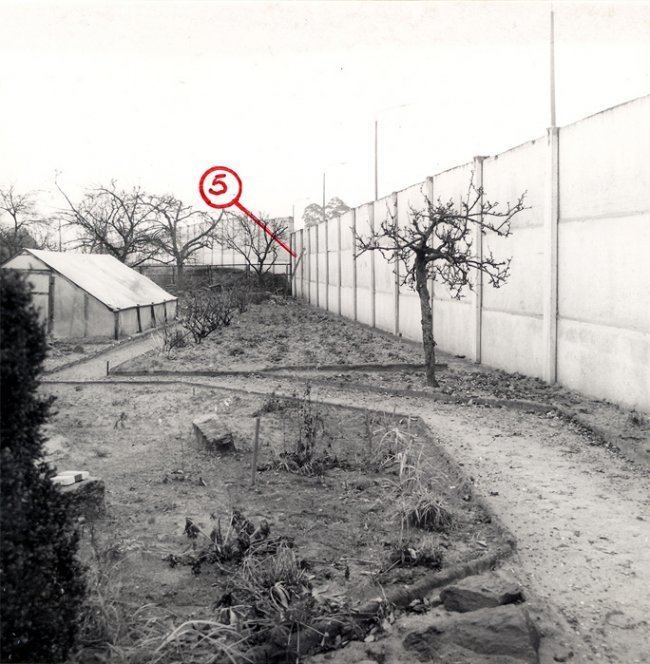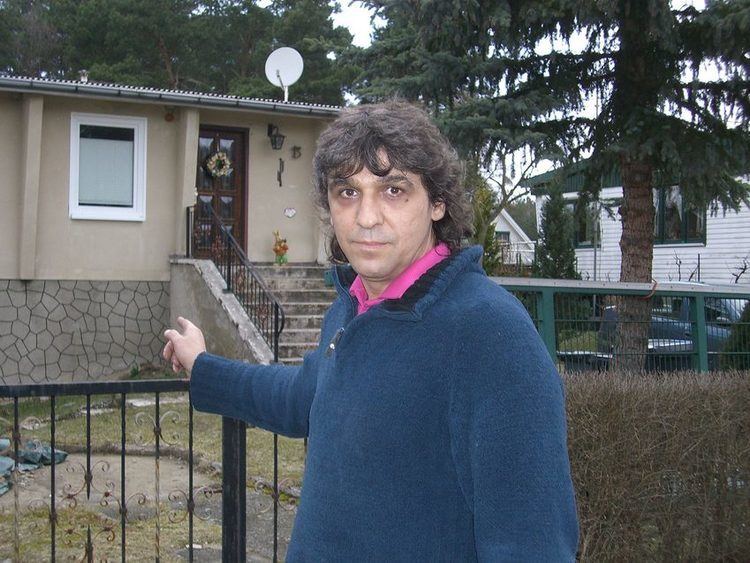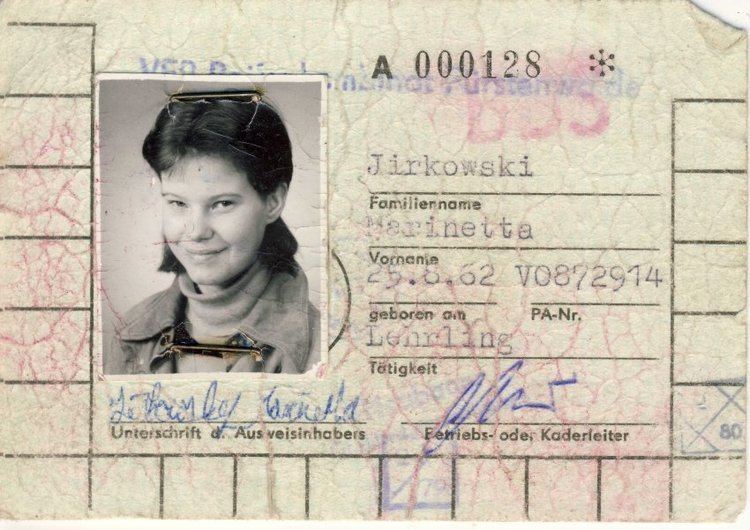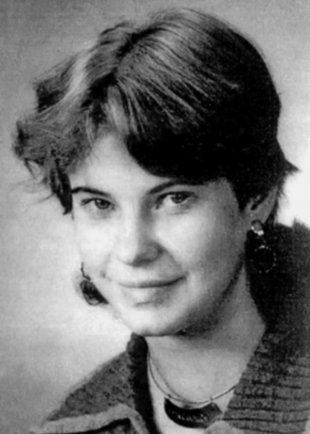Name Marienetta Jirkowsky | ||
 | ||
Cause of death Shot by a guard whilst attempting to enter West Berlin from Hohen Neuendorf, which was in the former GDR Body discovered Vacant property on Florastrasse52°39′38″N 13°17′05″E / 52.6605°N 13.2846°E / 52.6605; 13.2846 (Site of Marienetta Jirkowsky fatality) Monuments White Crosses, Berlin"Window Of Remembrance", Berlin"Marienetta Jirkowsky Monument", Hohen Neuendorf Died November 22, 1980, Hennigsdorf, Germany | ||
MICKI
Marienetta "Micki" Jirkowsky (25 August 1962, Bad Saarow, Oder-Spree, Brandenburg – 22 November 1980, Hennigsdorf, Oberhavel, Brandenburg) was a German woman killed trying to cross the Berlin Wall.
Contents
- MICKI
- Marinetta zum 50 Geburtstag am 25August 2012 ORIGINAL
- Biography
- Death
- Burial
- Aftermath
- Multi Media
- Memorials
- References

Marinetta (zum 50. Geburtstag am 25.August 2012)- ORIGINAL!
Biography

Marienetta Jirkowsky was born on 25 August 1962 in Bad Saarow, the only daughter to the skilled bricklayer Klaus Jirkowsky, and his wife, Astrid, employed by the Reifenkombinat Fürstenwalde, a tire manufacturing plant, where Marienetta would eventually take an apprenticeship and employment as a textile processor. She grew up in Spreenhagen, in Brandenburg, and last lived on Birkenweg 13, in Spreenhagen. "Micki," as her friends called her, was a "small, free-spirited and fun-loving person." She and her friends really "just wanted to live in peace, without any problems and without being forbidden to do anything," her friend Falko Vogt later explained. During the school year, she had little contact with other students. Instead, during her spare time, she helped in a retirement home in the neighboring village of Grünheide, where she was very popular with senior citizens. She began her Reifenkombinat apprenticeship in 1979. Falko Vogt had been thinking about escaping for a long time. He and Marienetta Jirkowsky met Peter Wiesner together in spring 1980. He, too, had not adjusted to the conditions in East Germany and had applied a number of times for an exit permit to leave the country. When Marienetta Jirkowsky turned 18, the legal age of an adult under East German law, she became engaged to Peter Wiesner. They planned to move in together in the fall of 1980. This decision, however, led to major conflicts with her parents, who were opposed to their relationship, and feared that they were going to lose their only child. To prevent this from happening, they succeeded in getting a police order to ban Peter Wiesner from having any contact with their daughter. He was divorced, drank a lot, changed jobs often, prone to violence, and had a history of being in trouble with the police. After that, the three were just waiting for the right moment to leave East Germany. They planned to flee together on the night of 22 November 1980. In preparation for their escape Peter Wiesner created a folding ladder, which consisted of separate pieces, in his apartment.

Numerous newspaper and magazine articles indicated that by this time, Marienetta Jirkowsky was three months pregnant. However, this has not been confirmed by something more reliable, such as an autopsy record from the hospital in Hennigsdorf, or a Stasi report.
Death

On 21 November the three young people took a train from Fürstenwalde to East Berlin to look for a good place to escape. They agreed that the spot they had previously checked out was not favorable for an escape, so they took the S-Bahn back to Hohen Neuendorf that evening. Peter Wiesner was familiar with the border there, from when he had worked nearby as a showman. They arrived at the Hohen Neuendorf S-Bahn station at around 12:30 AM, and worked their way across the property near the border. Contrary to their original plan, the three made a spontaneous decision to flee that very night. They did not know that, thanks to this decision, the two men had just barely missed being arrested early the next morning. An informant for the East German secret police, or Stasi, who was a member of their group of friends, had betrayed them and reported their escape plan to the Stasi. Since the fabricated ladder was still in Peter Wiesner's residence, they stole two ladders enroute; a telescoping ladder from the yard of a disused restaurant, and later, a folding stepladder from a neighboring residence at Florastrasse 2, which was approximately 150 meters from where they attempted their escape. Once in position where the escape would be attempted, they used the stepladder to peer over the interior wall and get a look at the border grounds.
For three hours that night, the three young people observed the routine at the border while bolstering each other’s courage. Then they separated the stepladder into two parts, and at about 3:30 AM, they used the front element (with the steps) to climb over the interior wall. The telescoping ladder was used to overcome the next obstacle, a 2.5 meter high signal fence. The two men overcame the fence without activating the alarm, but when Marienetta Jirkosky followed them, the alarm was triggered. The men had already reached the final obstacle, the 3.5-meter-high outer wall facing West Berlin, where the back (support) portion of the stepladder would be used to overcome the outer wall. Although part of the step ladder had sunk into the ground, Falko Vogt and Peter Wiesner were still able to reach the top of the wall, but then shots were fired at them from a watchtower located 160 meters away. Falko Vogt had already jumped down to the west side; Peter lay down on his stomach on top of the wall because his fiancée, who was standing on the top rung of the ladder, was too short to grasp the Wall with her hands. He reached out his hand to her to pull her up. Two additional border soldiers, who had run from their watchtower 230 meters away, also started firing at the fugitives. Marienetta Jirkowsky had already reached the top of the wall with her hands when she was struck by a bullet and fell off the ladder. Peter Wiesner fell down onto the west side of the Wall. A short time later, border soldiers retrieved the young woman and provided first aid. The regiment doctor ordered her to be transported to the nearest hospital in Hennigsdorf, where an emergency operation was conducted. Marienetta Jirkowsky died there at 11:30 AM from a bullet through her abdomen.
Marienetta Jirkowsky was the youngest of the 8 women killed at the Berlin wall, among the total of at least 140 victims.
Burial
On the day of the fatal escape attempt, Marienetta Jirkowsky’s father was summoned to the East German police in Fürstenwalde. At first all he learned there was that his daughter had been arrested at the border to West Berlin. He was not informed that she had been killed until two days later. The family was not allowed to publish an obituary. Spreenhagen, the 18-year-old woman’s hometown, was virtually sealed off by State Security agents when the urn containing her ashes was buried in the town’s cemetery. The funeral was attended by her immediate family on 14 December 1980.
Aftermath
On behalf of all the Allied city commanders, the French city commander protested that very day against the shots fired at Marienetta Jirkowsky and demanded that East Germany finally put a stop to their "inhuman practices."
The East German secret police went to great effort to prevent any information about the 18-year-old woman’s death from leaking out. Under no circumstances was a photograph of the dead woman to be published and many photographs of Marienetta Jirkowsky were confiscated from her friends and relatives. The East German secret police tried to make Peter Wiesner and Falko Vogt look like liars by passing a photograph of a woman who resembled Marienetta Jirkowsky on to the western media. The plan was to undermine the validity of all the reporting on the fatal escape attempt by having this photo identified as "false." Another step was taken to publicly discredit the two men who had fled: Informants working for the East German secret police were supposed to win over their confidence and then try to make them look like criminals. They were to "inconspicuously encourage them to spend large sums of money without deliberation, take out credit, etc., in order to set the preconditions for possible criminal behavior." Despite these measures, Falko Vogt and Peter Wiesner were able to provide detailed accounts of the case to the West. In early February 1981, they placed a cross at the site where they had escaped to honor their deceased friend. It was removed by a Stasi informant, Gero Hilliger (IMB Brunnen), and secretly brought to the Ministry of State Security in East Berlin. The Stasi also considered taking "measures to transfer the two men back to East Germany," specifically meaning, a plan to have them kidnapped and brought back to East Germany against their will.
In the aftermath of Marienetta Jirkowsky’s death, Falko Vogt became involved in spectacular acts to draw attention to the fate of his friend. On 6 February 1981 he placed charges of murder against the East German minister of defense, Heinz Hoffmann, with the Central Registry Office in Salzgitter. On 2 March 1981, during the Organization for Security and Co-operation in Europe follow-up conference in Madrid, he chained himself to the entrance gate of the Soviet Embassy in Madrid to denounce the East German government’s violation of human rights.
Fifteen years later, one of the gunmen was tried for a "less serious case of manslaughter" and sentenced as a youth by the Neuruppin district court to a prison term of one year and three months, which was commuted to probation.
Legislation to rename a traffic circle in Hohen Neuendorf which connected to Florastrasse, commemorating Marienetta Jirkowsky was introduced by its city council in 2009, but was vehemently rejected by her aunt and mother's sister, Bärbel Kultus (who was, since 1970 until the dissolution of the GDR, a high level Stasi informant, "GMS Bärbel"). She attempted to act as the spokesperson for the family, since both parents had already died. She insisted that there was no merit to have died at the Berlin Wall, and that mourning was a private family matter. Despite her opposition, after months of struggle, the decision was ultimately approved by the city council on 13 August 2010 and the traffic circle was renamed "Marienetta-Jirkowsky-Platz".
Multi-Media
Memorials
Memorials to her death are located in the "White Crosses" memorial, next to the Reichstag building, in the "Window Of Remembrance" of the Berlin Wall Memorial in Berlin and near the former scene of the attempted escape, in Hohen Neuendorf.
